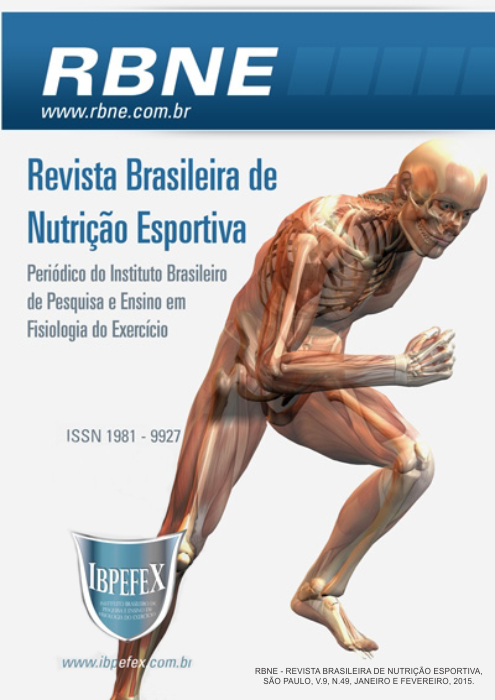Analysis of BCAA labels sold in Volta Redonda-RJ
Abstract
The BCAA are substances formed from the combination of leucine, isoleucine and valine. In Brazil according to ANVISA, they needn’t records because of lack of specific legislation. However, it’s must comply with the composition and quality requirements established by technical regulations. The present study aimed to evaluate according ANVISA regulatory parameters the labels of the products marketed as branched chain amino acids -BCAA. This is an observational study. The products were selected from a store specializing in nutritional ergogenics. All BCAA had her evaluated packages according to resolutions of ANVISA. To tabulate the results, we used classical descriptive statistical analysis models. Most products were evaluated in accordance with the relevant marketing BCAA Brazilian’s law, with 92.6 % compliance with the legislation of the information. Although not yet scientifically proven, BCAAs are highly used in sports. Itis necessary to monitor of use in order to adapt them the requirements proposed by ANVISA.
References
-Brasil. Agência Nacional de Vigilância Sanitária -ANVISA. Resolução nº 23, de 16 de março de 2000. Dispõe sobre os procedimentos básicos de registro e dispensa da obrigatoriedade de registro de produtos pertinentes a área de alimentos. Diário Oficial da República Federativa do Brasil. Brasília. de 16/03/2000.
-Brasil. Agência Nacional de Vigilância Sanitária -ANVISA. Resolução nº 18, de 27 de abril de 2010. Dispõe sobre alimentos para atletas. Diário Oficial da República Federativa do Brasil. Brasília.28/04/2010.
-Brasil. Ministério da Saúde. Secretaria de Vigilância Sanitária. Portaria nº 29, de 13 de janeiro de 1998. Aprova o Regulamento Técnico referente a Alimentos para Fins Especiais. Diário Oficial da República Federativa do Brasil. Brasília. 13/01/1998.
-Carvalho, I.I. BCAA (Aminoácidos de Cadeia Ramificada). Fitness & Performance Journal. Vol. 4. Num. 5. 2005. p. 253.
-Gomes Júnior, C.A.; e colaboradores. Influência da Suplementação de BCAA Sobre a Fadiga Neuromuscular. TCC de Graduação em Educação Física. Faculdade de Educação Física. Centro Universitário Católico Salesiano. Lins. 2009.
-Gonçalves, G.H. A suplementação com aminoácidos de cadeia ramificada na atividade física. In: 8º Mostra Acadêmica Unimep. 8. 2010. São Paulo. Desafios da Educação Superior na Agenda do Novo Milênio. São Paulo. 2010. Disponível em: http://www.unimep.br/phpg/mostraacademica/anais/8mostra/4/96.pdf. Acesso em: 11/03/2014.
-Moreira, S.S.P.; e colaboradores. Avaliação da adequação da rotulagem de suplementos esportivos. Revista Corpus et Scientia. Vol. 9. Núm. 2. 2013. p. 45-55.
-Paula, A.M.C.; Frota, F.H.S. Avaliação dos rótulos de suplementos nutricionais para praticantes de atividade física x propaganda x direito do consumidor. Dissertação de Mestrado em Políticas Públicas. Universidade Estadual do Ceará. Fortaleza. 2008.
-Uchida, M.C.; e colaboradores. Consumo de aminoácidos de cadeia ramificada não afeta o desempenho de endurance. Revista Brasileira de Medicina do Esporte. Vol. 14. Num. 1. 2008. p. 42-45.
Authors who publish in this journal agree to the following terms:
- Authors retain the copyright and grant the journal the right of first publication, with work simultaneously licensed under the Creative Commons Attribution License BY-NC which allows the sharing of the work with acknowledgment of the authorship of the work and initial publication in this journal.
- Authors are authorized to enter into additional contracts separately for non-exclusive distribution of the version of the work published in this journal (eg, publishing in institutional repository or book chapter), with acknowledgment of authorship and initial publication in this journal.
- Authors are allowed and encouraged to post and distribute their work online (eg, in institutional repositories or on their personal page) at any point before or during the editorial process, as this can bring about productive change as well as increase impact and impact. citation of published work (See The Effect of Free Access).






